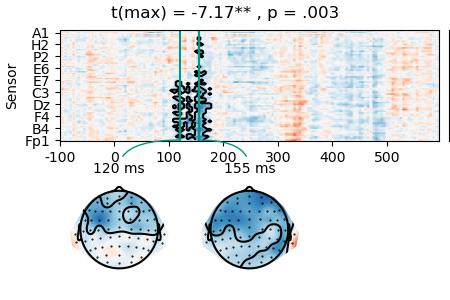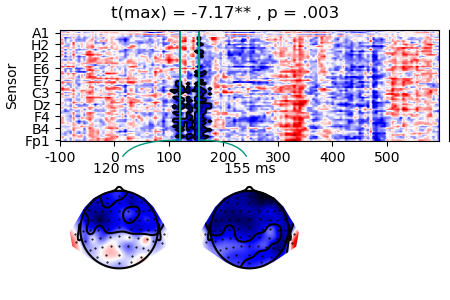Note
Go to the end to download the full example code
Two-stage test
When trials are associated with continuous predictor variables, averaging is often a poor solution that loses part of the data. In such cases, a two-stage design can be employed that allows using the continuous predictor variable to test hypotheses at the group level. A two-stage analysis involves:
Stage 1: fit a regression model to each individual subject’s data
Stage 2: test regression coefficients at the group level
The example uses the same simulated data and design used in Multiple regression. The data are meant to vaguely resemble data from a word reading experiment, but not intended as a physiologically realistic simulation.
# sphinx_gallery_thumbnail_number = 1
from eelbrain import *
Stage 1
Generate simulated data: each function call to datasets.simulate_erp()
generates a dataset for one subject (in a real experiment this would be
replaced with a function that loads data for this subject).
For each subject, a multiple regression model is fit using n characters and
cloze probability as continuous predictor variables.
lms = []
for subject in range(10):
# generate data for one subject
ds = datasets.simulate_erp(seed=subject)
# Re-reference EEG data
ds['eeg'] -= ds['eeg'].mean(sensor=['M1', 'M2'])
# Fit stage 1 model (samples=0 because we do not need permutations at stage 1)
lm = testnd.LM('eeg', 'n_chars + cloze', data=ds, samples=0, subject=str(subject))
lms.append(lm)
Stage 2
Prepare a Dataset with the first level statistic of interest.
rows = []
for lm in lms:
rows.append([lm.subject, lm.t('intercept'), lm.t('n_chars'), lm.t('cloze')])
# When creating the dataset for stage 2 analysis, declare subject as random factor;
# this is only relevant if performing ANOVA as stage 2 test.
data = Dataset.from_caselist(['subject', 'intercept', 'n_chars', 'cloze'], rows, random='subject')
data
Now we can test whether the first stage estimates are consistent across subject.
result = testnd.TTestOneSample('n_chars', data=data, pmin=0.05, tstart=0, tstop=0.300)
p = plot.TopoArray(result, t=[0.120, 0.155, None], title=result, head_radius=0.35)
p_cb = p.plot_colorbar(right_of=p.axes[0], label='t')

Permutation test: 0%| | 0/1023 [00:00<?, ? permutations/s]
Permutation test: 15%|█▍ | 153/1023 [00:00<00:00, 1527.57 permutations/s]
Permutation test: 32%|███▏ | 329/1023 [00:00<00:00, 1663.42 permutations/s]
Permutation test: 49%|████▉ | 503/1023 [00:00<00:00, 1693.72 permutations/s]
Permutation test: 67%|██████▋ | 682/1023 [00:00<00:00, 1725.43 permutations/s]
Permutation test: 85%|████████▍ | 867/1023 [00:00<00:00, 1764.85 permutations/s]
Permutation test: 100%|██████████| 1023/1023 [00:00<00:00, 1738.12 permutations/s]
Instead of t-values, we might want to visualize regression coefficients:
rows = []
for lm in lms:
rows.append([lm.subject, lm.coefficient('n_chars')])
data_c = Dataset.from_caselist(['subject', 'n_chars'], rows, random='subject')
# mask regression coefficients by significance to add outlines to plot
masked_c = data_c['n_chars'].mean('case').mask(result.p > 0.05, missing=True)
p = plot.TopoArray(masked_c, t=[0.120, 0.155, None], title=result, head_radius=0.35)
p_cb = p.plot_colorbar(right_of=p.axes[0], label='µV', unit=1e-6)

- Of course, other tests could be applied at stage 2, for example
T-tests to compare coefficients for two different regressor, or two differen subject groups
ANOVA for multiple regressors and/or subject groups
Multiple regression models with subject variables to test for individual differnces